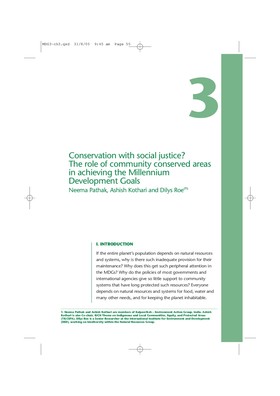Conservation with social justice? The role of community conserved areas in achieving the Millennium Development Goals

Chapter three of the Millennium Development Goals.
If the entire planet's population depends on natural resources and systems, why is there such inadequate provision for their maintenance? Why does this get such peripheral attention in the MDGs? Why do the policies of most governments and international agencies give so little support to community systems that have long protected such resources? Everyone depends on natural resources and systems for food, water and many other needs, and for keeping the planet inhabitable.
CCAs appear to be a valuable mechanism both for expanding the scope of the MDG7 indicators and for making linkages between environmental sustainability and human well-being. CCAs cover a wide range of ecosystem types – far more than the forest emphasis of MDG7. Through their focus on sustainable livelihoods, human rights and democracy, CCAs can also make clear contributions to
the many dimensions of poverty articulated by the MDGs. However, ensuring this contribution does require concerted action at local, national and international levels, to increase the recognition of CCAs. Very considerable steps have been taken in international policy processes in the last two years. Action is now needed at the national level to ensure that these valuable local institutions can fulfil their potential and deliver on conservation with social justice.
Cite this publication
Available at https://www.iied.org/g01283